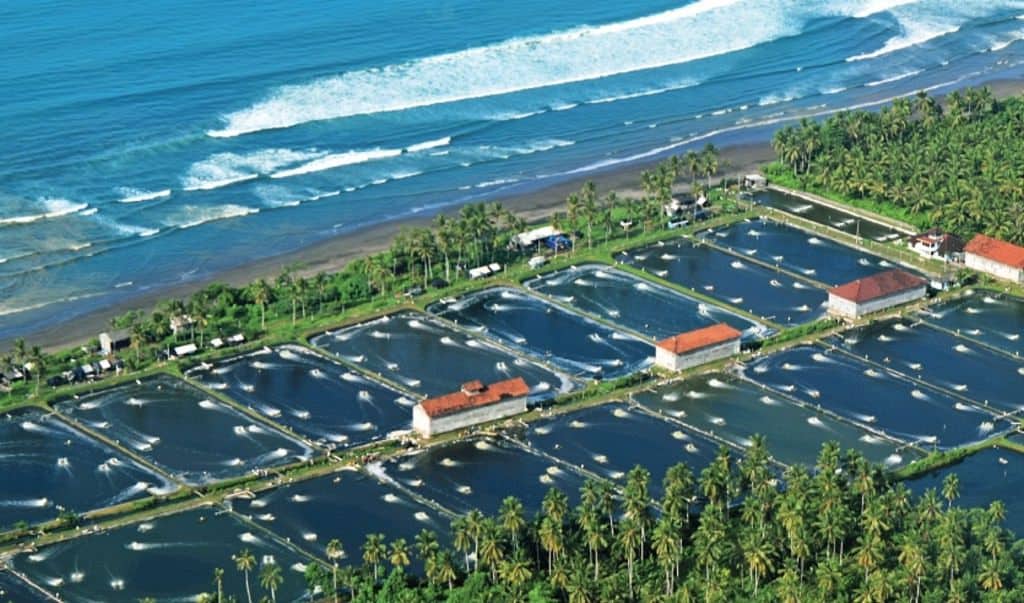Some of you may like to learn a bit more about what happens around Indonesia’s vast marine areas. Lida will share some short info stories every now and then, we hope you like them. This one is about Indonesian aquaculture.
Last time I shared how the fisheries sector plays an important role in contributing to national food security and employment in Indonesia. This time I like to explore some of the other ways that Indonesia tries to achieve a target of providing approximately 54 kg of fish protein for its people to eat.
The Government of Indonesia has an aquaculture production target of 37 million tonnes per year by 2030 (Directorate General of Aquaculture Fisheries, 2017). This target was calculated following ambitions for protein- and livelihood generation. It does, however, not take into account input requirements for feed, land, labor, finance, infrastructure, nor the potential environmental impact caused by output variables such as nitrate and other chemical components that come with aquaculture.
Multiple studies and reports warn of the significant environmental impacts of aquaculture, most people are aware of the challenges for coastal protection and sedimentation in SE Asia’s coastal areas related to mass clearing of mangrove forests for shrimp farming. Many people have heard from diseases spreading from fish farms into natural fish stocks and from the burden on wild-capture fisheries related to the fact that many farmed fish eat fish.
At the same time, around the globe, discussions on the importance of maintaining a well-balanced diet for human health and that of the planet, indicate that protein from fish scores higher marks for health purposes than other animal sources. Recently, several studies have come out suggesting that the climate footprint of producing fish protein also compares favorably to production of other animal proteins. It is in this context that looking at some of the developments in Indonesia’s aquaculture sector is interesting.
In general, our destinations and routes are in the more remote parts of Indonesia. Aquaculture activities have not reached many of the areas that we visit. The slow rate of expansion may serve the agenda of experts and other concerned with the environmental impacts of aquaculture expansion, but the need to feed a growing Indonesian, regional, and indeed global population, paired with the national ambition to retain positive economic growth also particularly for the poorer communities in remote parts of Indonesia, may change this situation.
Fortunately, some initiatives and projects are underway with good potential to reduce the negative footprint of different types of aquaculture and to improve the future outlook for a more sustainable sector in Indonesia. Lots of start-up companies founded by young Indonesians who are keen to help produce food and provide jobs sustainably in remote areas, are out and about developing technological solutions to improve environmental and business performance of aquaculture farms. Important lessons are shared, and progress is promising. However, public budgets to support aquaculture growth are on the decline since 2016 and while the government tries to motivate the business community to step up private investment in the aquaculture sector, this is not happening much yet.
Through 2030, annual growth for production of selected species is targeted between 6 – 18%. Nationally, a quantified area is targeted for aquaculture in the ocean/coastal area, in brackish-water, and in fresh-water bodies. A government-generated map exists with indications of areas for these different ecosystems, but at this stage, it is not clear if these areas are integrated into local or provincial spatial plans. The National Planning Agency’s 20-year strategy for 2005-2025 mentions the importance of using economically relevant enabling conditions such as the competitive advantages of different regions, and the availability of quality and competitive human resources – labor.
Even when the ambitions and needs to develop local economies around the remoter parts of Indonesia are high, not every area has a similar suitability for aquaculture development. Water quality, vegetation, and topography are important conditions, followed by soil characteristics, accessibility, and tidal fluctuation. Some variables are extremely important for certain types of aquaculture, think about the importance of having access to stable levels of electricity for shrimp farming. Other types of aquaculture are less affected by these, such as the farming of tilapia, but here profit margins are lower, resulting in the trend to develop low investment, extensive farm approaches over large areas of land.
All in all, I don’t think that we will see rapid expansion of aquaculture in eastern Indonesia any time soon. In that respect, and for my work advising on Indonesia’s coastal and marine resource management, I find it interesting to consider the different roles of government, private sector, academia and NGOs towards a sustainable growth in this sector. While some of these actor groups are starting to collaborate to improve the trajectory of aquaculture development, each of you – our Seven Seas adventurers – can also think about what type of seafood you will chose to enjoy back home.
Please take a look around next time you join the Seven Seas for an adventure,
you may spot some interesting coastal aquaculture activities around the boat!
Lida Pet-Soede
NOTE :
To reserve your spots or see available trips, please check out our schedule page :
Schedule & Availability
Please also don’t hesitate to reach out to us at [email protected] should you require any further information or need recommendations for accommodation or flights etc. Our reservation team would be more than happy to assist. Cheers!

